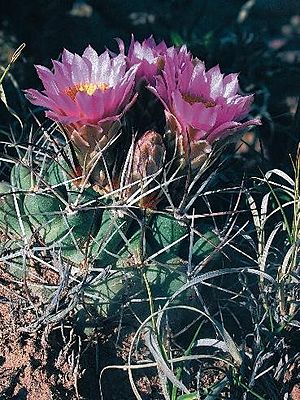Colorado hookless cactus facts for kids
Quick facts for kids Colorado hookless cactus |
|
|---|---|
 |
|
| Conservation status | |
| Scientific classification | |
| Kingdom: | |
| (unranked): | |
| (unranked): | |
| (unranked): | |
| Order: | |
| Family: | |
| Subfamily: | |
| Tribe: |
Cacteae
|
| Genus: | |
| Species: |
S. glaucus
|
| Binomial name | |
| Sclerocactus glaucus (K.Schumann) L.D.Benson
|
|
The Sclerocactus glaucus, also known as the Colorado hookless cactus, is a special and rare type of cactus. It grows only in a small part of Colorado, in the United States. You can find it between the cities of Grand Junction and Montrose. This cactus is considered a threatened species, which means it needs protection to survive.
Contents
What Makes It Special?
This cactus has a cool shape! It looks like a cylinder, like a can. It can grow up to 28 centimeters (about 11 inches) tall and 9 centimeters (about 3.5 inches) wide. But often, it's much smaller.
Hiding from the Sun
During the dry season, when there's not much water, this cactus can actually shrink! It might even disappear completely under the soil. This helps it save water and survive the heat.
Spines and Flowers
Each part of the cactus where spines grow, called an areole, can have up to 12 white spines that stick out like rays. It also has several longer spines in the middle. These central spines can be white, reddish, or black and are about 1 to 2 centimeters long.
When it blooms, the Sclerocactus glaucus produces beautiful, funnel- or bell-shaped flowers. These flowers can be up to 6 centimeters (about 2.4 inches) long and have pretty pink petals. Inside the flower, you'll find white or green filaments and yellow parts called anthers. After the flower, a barrel-shaped fruit grows, which can be up to 3 centimeters long.
Where It Lives
The Colorado hookless cactus likes to grow in specific places. It prefers open areas with gravelly clay soil. You can often find it on flat areas above floodplains or on the sides of mesas.
Nearby Rivers and Plants
This cactus often lives near big rivers like the Green, Colorado, and Gunnison Rivers. It's part of desert plant communities where you'll see many saltbush and sagebrush plants. Sometimes, it also grows in woodlands with pinyon pine and juniper trees.
Other plants that share its home include:
- Shadscale (Atriplex confertifolia)
- Galleta grass (Hilaria jamesii)
- Black sagebrush (Artemisia nova)
- Indian rice grass (Stipa hymenoides)
- Strawberry hedgehog cactus (Echinocereus triglochidiatus var. melanacanthus)
- Simpson's pincushion cactus (Pediocactus simpsonii)
- Prickly pear cactus (Opuntia polyacantha)
- Winterfat (Krascheninnikovia lanata)
- Yucca (Yucca harrimaniae)
- Snakeweed (Gutierrezia sarothrae)
- Low rabbitbrush (Chrysothamnus viscidiflorus)
- Sand dropseed (Sporobolus cryptandrus)
- Salina wildrye (Leymus salinus)
Why It Needs Protection
The Colorado hookless cactus faces several challenges that threaten its survival.
Habitat Loss
Many of the places where this cactus grows are being changed or destroyed by human activities. These include:
- Searching for oil and gas.
- Building new homes and towns.
- Mining for rocks.
- Allowing too many farm animals to graze in the area.
A large pipeline called the TransColorado Pipeline has also affected its habitat. As more people move to this rural area because of the energy industry, more of the cactus's home might be lost.
Illegal Collection
Another big problem for this cactus is that people sometimes try to collect it illegally from its natural home. This is called poaching, and it harms the wild populations.
See also
 In Spanish: Sclerocactus glaucus para niños
In Spanish: Sclerocactus glaucus para niños


